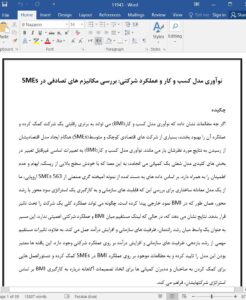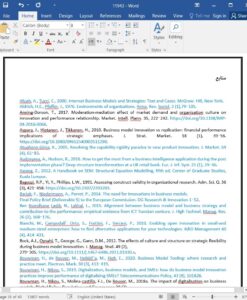Abstract
Although research has shown that business model innovation (BMI) can create a firm's competitive advantage and enhance its performance, many small and medium-sized enterprises (SMEs) fail to obtain the expected outcomes when innovating their business model. Business Model Innovation (BMI) leads to irreversible fundamental changes in key components of a company's business model, which means it carries with it a high level of risk, ambiguity and uncertainty. Drawing on the data from a cross-industry sample of 563 European SMEs, we apply structural equation modelling to examine how a firm's performance is affected by innovating its business model. A conceptual model is developed to examine how organisational capabilities and implementation of a profit- or growth-oriented strategy, as materialised in BMI, affect a firm's overall performance. The results indicate that, while the direct link between BMI and firm performance is not significant, this path is fully mediated through efficiency growth, organisational capabilities and revenue growth. Furthermore, there are significant direct effects from efficiency growth, organisational capabilities and revenue growth on firm performance. These findings confirm the validity of the model and contribute to existing literature on BMI efforts in SMEs and provide guidelines to help company owners/managers implement informed decisions about the implementation of BMI based on their firm's strategies.
1. Introduction
Almost all business owners and managers want their firm to perform well. Revolutionary advancements in technology and rapid changes in regulations and the behaviour of customers and competitors alike create serious challenges for companies wanting to do business. To sustain continued growth, become more profitable and survive, firms need to adapt their business logic (Vukanovi´c, 2016). Businesses can either innovate their products, processes and marketing strategies, or they can innovate their business model. Since the advent of the Internet, the notions of business model (BM) and business model innovation (BMI) have received considerable attention in industry and academia (Aspara et al., 2010; Foss and Saebi, 2017). BM describes the logic of how a company creates, delivers and captures values (Teece, 2010), while BMI refers to the changes in the key elements of a firm’s BM or the architecture linking these elements in a structured, novel and nontrivial way (Foss and Saebi, 2017). As a method of innovating and adapting to a changing market (Hartmann et al., 2013), a well-designed BM is able to create and deliver value propositions that are attractive to customers. It helps create revenue streams and competitive advantages, and enables substantial value capturing by the business delivering an innovative and different portfolio of products and services (Teece, 2010).











